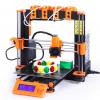About
3D printers use digital models to fabricate three-dimensional objects, a layer at a time. The process of 3D printing - called additive manufacturing or rapid prototyping in engineering and commercial settings - has been around for almost 30 years. Low cost 3D printers, do-it-yourself kits and open source software are bringing the technology into broader use.
Our 3D Printer
Prusa i3 Mk2S with MultiMaterial (MM) upgrade. The MM upgrade allows us to print with 4 different filaments during the same print job. This gives us the flexibility to create multi-color prints or use a dissolvable support material for intricate designs.
Filament Types
-
Common
-
PLA (Polymer Polylactide): is a plastic made from plants (usually corn or sugarcane) this is also labeled with a 7. PLA plastics don’t contain BPA; no safety concerns have been raised about using PLA plastic with food. Quicker print speeds than other 3D printable plastics.
-
ABS (Acrylonitrile Butadiene Styrene): ABS has a strong resistance to corrosive chemicals and/or physical impacts. Stable up to 150° C. Should be printed in a vented location. Print times are longer than PLA and are susceptible to some shrinkage so that has to be considered when designing something using ABS.
- PETG (Polyethylene Terephthalate Glycol): Similar to both PLA/ABS, although PETG is stronger but takes longer to print with. It's also slightly more flexible than PLA.
-
PLA (Polymer Polylactide): is a plastic made from plants (usually corn or sugarcane) this is also labeled with a 7. PLA plastics don’t contain BPA; no safety concerns have been raised about using PLA plastic with food. Quicker print speeds than other 3D printable plastics.
-
Special
- Woodfill
- Metal composites
- Transparent
- Dissolvable support material
3D Printing Tips
-
File Format: Please provide a Stereolithography file, with an STL extension (.stl). Most CAD programs as well as some free 3D modeling software packages can save or export in this format.
-
Dimensions: Your 3D model must fit within the build envelope of our printer, which is 25 x 21 x 20 cm or 9.84 x 8.3 x 8 in. The minimum thickness of a layer is 0.15 mm so the smallest features that will accurately be produced must be at least this value. It is recommended that part thicknesses be at least 0.15 mm or greater.
- Other print settings such as infill percentage, infill shape, print speed, etc : Consult with us if you have questions.
How to Submit Jobs
If you would like us to 3D print something for you please place a COPY of your .STL file in:
S: \3D_Prints
OR
if necessary, follow these instructions to manually map the following network share:
\\casfiles.biossys.oregonstate.edu\share\3D_Prints
Please send all requests for 3D printing (this is for ROOTS faculty, staff, and graduate students) to support.roots@oregonstate.edu. If you are using Outlook, you can type in roots.support and select the contact from the global address list. There is no charge to ROOTS customers for 3D printing but if you need a lot printed we may ask you to furnish your own filament.
Please include the name of the file, any specific print parameters you'd like selected, and your contact information in your email. If you have questions on which parameters you need please let us know so we can meet with you.
Please submit your 3D print request well in advance of when you need it. Due to the nature of the tech there is no such thing as a rush job so please plan accordingly. Please plan to submit a minimum of 1 week (7 days) in advance of the day needed. At the very least, please send an email to Roots Support 7-10 days or more in advance, to be sure someone will be available to print your model, and that the 3D printer is operational.
Helpful Links
- OSU Library 3D printing information
- OSU College of Business 3D printing guide
- OSU EECS Department Tekbots 3D printing, laser cutting, and PCB design

